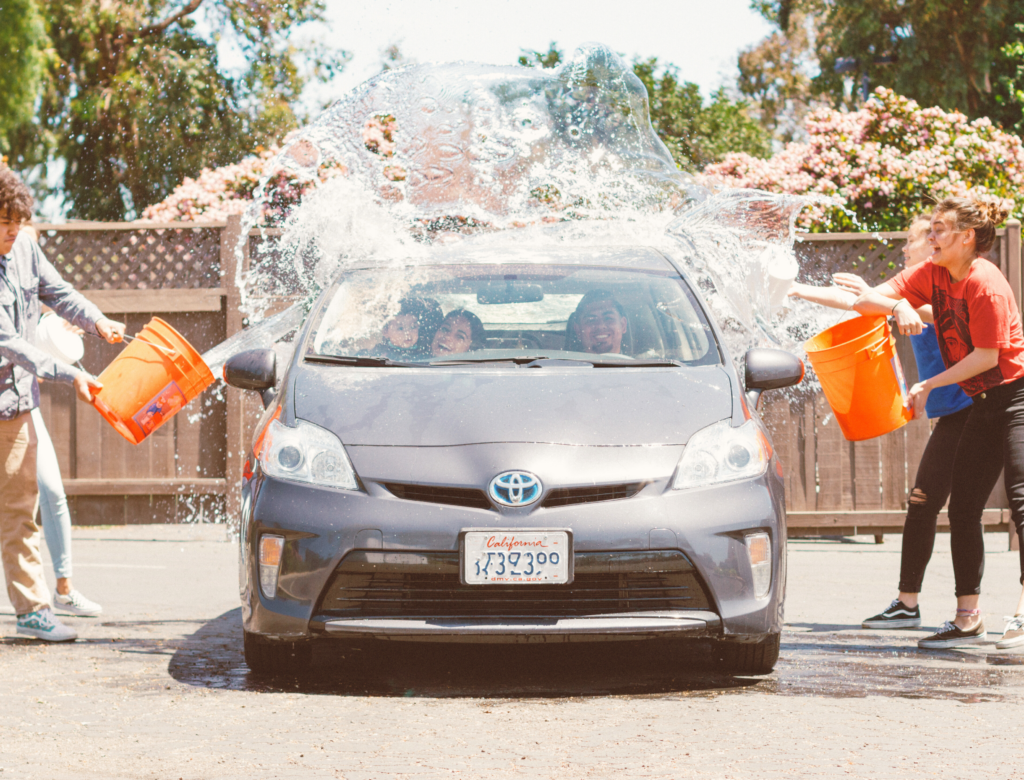
Most people believe the key to a successful school fundraiser is selecting the best idea.
It’s true that many fundraiser ideas indeed have a range of revenue generation potential.
For example, a bake sale for the local high school might have a revenue range of a few hundred to a few thousand dollars, whereas an alumni network fundraising campaign for a university could earn anywhere from six figures well into eight figures.
However, the revenue you earn within that range depends largely on key variables within your control, such as strategic planning, thorough research, and community involvement.
Below, we categorized some of the most popular fundraising ideas for schools based on revenue-earning potential and the effort required, and we’ll also discuss how you can strategically plan and execute these ideas to maximize revenue.
Short-term fundraisers for schools
These short-term fundraising ideas are for you if your goal is to raise a few hundred or a few thousand dollars. They’re relatively easy to execute and can be completed in a matter of days or weeks.
These are also excellent fundraiser ideas if you plan to primarily leverage students to execute the fundraiser, as many students from elementary school to university can assist with these fundraiser campaigns.
Elementary and middle school fundraising ideas
Effective fundraising ideas for elementary and middle schools often involve one-off events, product sales, and donation drives.
One-time events
Some popular one-time events for elementary and middle schools include:
- Bake sales
- Car washes
- Movie nights
- Talent shows
- Field days
- A school sleepover, in which you invite students to sleep in the school gym under teacher supervision while the parents take a night off
A one-time school fundraising event is an effective idea because it only lasts a few hours and students often enjoy participating, making it easier to promote and drum up excitement.
To get started, survey your community and ask them which type of fundraiser they would enjoy the most. The best fundraiser idea is ultimately the idea your community is most excited about, as word of mouth will be the best promotion.
Select a date and time and begin planning it at least eight weeks in advance so you’ll have plenty of time to promote the event.
Next, enlist a group of volunteers who will help you manage the event. The best volunteers are often parents, teachers, and other community members who will benefit from the fundraiser.
To promote the event, list it on the school’s social media page and ask your volunteers to act as ambassadors and share it on their social media profiles.
You can also host a “share” contest to amplify promotion. For example, you can reward the person who generates the most social media engagement with a free basket of baked goods, a free car wash, etc.
Following the event, analyze the promotional efforts that worked the best and note those so that you can replicate them at future events.
Product sales
These events are easy to run as students and ambassadors do most of the selling for you. It’s also a fantastic way to educate students about sales and finances.
In addition, unlike one-time events that can be ruined or canceled due to rain or other unforeseen circumstances, product sales typically last for several days or weeks so that your profits aren’t dependent on the perfect execution of a single day.
The challenge with these events is that students must be motivated to sell.
To make product sales successful, give students (and parents if they’re involved) specific scripts to sell the products and a list of potential prospects they can target (their neighbors, friends from dance class, etc.). You can also provide social media scripts to help students promote it online.
To further encourage student participation, create a leaderboard that tracks the top-selling students and provide mini rewards for the top sellers of each week and a grand prize for the overall top seller.
You can also ask the top sellers to reveal their selling strategies to help others improve their sales.
Donation drives
Drives are relatively easy to manage and are highly profitable. You can either collect donated items to give directly to students or families that need them (such as school supplies or long-life pantry items) or collect donated items to sell to an organization and keep the funds.
Example: Shoe drive
To run a shoe drive, students collect and donate shoes to you. Then, you partner with a shoe drive facilitator like Funds2Orgs, and that organization calculates the value of the shoes and writes you a check.
The biggest challenge with a drive is getting students actively involved.
To market your campaign, create a social media contest and offer a grand prize to the student who generates the most reach and engagement promoting the event. For example, you can ask them to use a specific hashtag to promote the campaign and then measure who attains the most reach using that hashtag. You can also offer awards for the most creative videos promoting the shoe drive.
You can also ask the PTA and other community organizations to promote the fundraiser to their members.
If you need more help, many shoe drive facilitators also offer marketing tools and advice to help you collect more shoes.
High school and college fundraising ideas
The following ideas are great for involving high school students and college students either as part of the attraction or as digital peer-to-peer promoters. Keep in mind that any high school fundraising ideas you implement will have more parental involvement than the same ideas applied in a college setting.
Sports competition
People love attending sports events and are accustomed to paying for this kind of entertainment.
This means sports competitions are excellent fundraisers as the public genuinely enjoys these events, and friends and family of the athletes are more likely to attend to show their support.
Marketing sports competition fundraisers is also easier because the athletes want to talk about the event with their friends and family.
You can have fun marketing the event on social media by recording videos of the players practicing and then tag them in social media posts to further spread the word.
Another reason why sports competitions are excellent fundraisers is because you can monetize them in multiple ways. For example, you can sell food, merchandise, and other items at the event to boost the total revenue.
Crowdfunding campaigns
Crowdfunding campaigns are great because you can set them up in a day or two and execute the entire campaign online.
You can use a platform like 99Pledges or DonorsChoose to create and sell different types of campaigns.
To promote your crowdfunding campaign, write a compelling description of your mission and how you’ll use the donations.
Creating a heartfelt video to promote the cause is also a great way to promote the event. Reach out to your list of past participants and ask if they’d give a quick video testimonial outlining how much fun they had participating, how they hit their donation goals, and how it made them feel connected to their community.
To further promote the campaign, recruit a group of students and/or high-profile ambassadors and ask them to share it on their social media profiles. You can also reward the person who generates the most engagement.
Another fun promotion idea is to ask people to create their own social media content (such as a TikTok video) promoting the event and give a prize to the person who generates the most engagement on their content.
Peer-to-peer fundraisers
Peer-to-peer fundraisers are similar to crowdfunding campaigns, though instead of relying on you to manage the entire campaign, these fundraisers leverage students and the community to create their own fundraising pages.
Then, the students and community members promote their own individual fundraising pages to their friends and family online through social media or email.
The benefit of these fundraisers is that students tend to take more ownership of the campaign and promote it more enthusiastically than if they just share a crowdfunding campaign you created. As a result, they can generate more donations.
The downside is that they can be a bit more challenging to manage as you’ll have to monitor hundreds or even thousands of fundraiser pages. There are peer-to-peer fundraising platforms that make it easier to track donations across various student pages.
Check out our list of 40 peer-to-peer fundraising ideas to inspire you!
Community charity runs/walks for all levels of education
Charity runs and walks allow you to tap into the local community rather than just your school community. This makes them suitable for all levels of education. It also makes them potentially more profitable than fundraising initiatives that are limited to your school or institution.
To organize a run or walk, collaborate with your city to ensure you can create a safe route. Depending on the size of your run or walk, you might need permission or assistance from the local police department.
It’s also a good idea to check in with your legal department to ensure your organization is protected if someone gets injured. Ensure your insurance will cover you in the event of an accident occurring.
Once you have all the necessary paperwork, begin planning the event by choosing a pricing model. To maximize revenue, offer different pricing tiers. For example, you can make it relatively cheap to enter the walk/run (say, $10) and then offer higher pricing tiers, including upsells, like limited edition t-shirts, a special lunch/dinner following the event, and special recognition for their support.
Give people the opportunity to sign up for these higher pricing tiers before the event, and when they arrive, offer them the opportunity to join a higher pricing tier again.
You can also offer other items for sale during the event, like merchandise and baked goods, to generate more profits from the event.
In addition to maximizing participant revenue, you can target local businesses and offer sponsorship opportunities. For example, you can allow them to post a banner, include their brand logo on your website, and promote it on social media.
To promote the event, post flyers around the town and ask all of your sponsors to share on social media that they’re sponsoring your event.
Medium-term fundraisers for schools
If your goal is to raise anywhere from four to low five figures, these medium-term fundraising ideas are excellent vehicles to help you achieve those goals.
They require a little more organizational effort than the short-term fundraisers mentioned above, but they yield higher returns and are a great option for grade schools, colleges, and universities.
Raffles
Raffle fundraisers can be highly lucrative, depending on the prize you select.
For example, if you partner with a car dealership and give away a car, you can probably sell a ton of tickets for a relatively high price.
The most challenging aspect of raffle fundraisers is finding great partners with enticing prizes.
Some highly lucrative raffle prizes include cars, paintings, and vacation packages.
However, it doesn’t necessarily have to be a major prize. It could also be a free class, a nice dinner, furniture, or a gift basket.
To find and choose partners, reach out to local businesses and pitch to them that they’ll receive free marketing by donating a good or service to your raffle.
The key is to make sure that the raffle prize is relevant to your target market (parents, teachers, or students). For example, a wine basket may not be appropriate if you’re doing fundraising for an elementary school.
Once you have several partners committed to your raffle, ask them to promote it on their social media pages, email lists, and websites to amplify reach.
Auctions
Auctions are similar to raffles, though instead of selling tickets, you’re using the proceeds from the sale to raise money.
To collect auction items, reach out to local businesses and tell them about your auction and how donating an item or service will give them free marketing. You can also research the tax benefits businesses receive for donating an item and present them to donors.
Once you have collected the items for consignment, ask the businesses to promote the auction and their donated item(s) on social media and their websites to generate more reach.
You can run your auction online, host a live event, or use a hybrid model.
While hosting a live event may be more costly, it can be much more profitable depending on your chosen venue.
First, you’ll be able to sell other items (event tickets, food, etc.).
Second, people tend to bid higher in front of their peers, as giving is often considered a sign of status.
If you don’t have the resources to host a live auction, online auctions are also excellent options as they require fewer resources to execute and more people may participate as it doesn’t require them to take time out of their day to attend an event.
Grant writing
Plenty of government grants are usually available that provide educational institutions access to support for different initiatives.
You can view a full list of grant opportunities on the US Department of Education’s website, many of which are available to nonprofit organizations.
These grants range from a few thousand dollars to well over six figures, though you typically have to apply for them.
One option is to hire a grant writer to write your grants for you. Find one who is knowledgeable in the process and has previous experience writing similar grants.
As you’re hiring a grant writer, ask them for past work examples and how they approach the grant writing process. Ideally, hire someone who has written (and won) grants similar to the ones you’re applying for.You can use a platform like Grant Writer Team to find and hire excellent grant writers.
If you want to write your grant proposals in house, you can leverage grant-writing tools to guide you in the process. There are some AI tools made specifically for this purpose that can provide you with samples, first drafts, and help you improve your proposals based on best practices.
Long-term fundraisers for schools
If you’re looking for fundraising campaign ideas that generate recurring revenue, we’ll introduce you to a few different options below.
Most of these fundraisers require extensive research on the specific donors you plan to target and more personalized asks.
Nevertheless, they can yield millions of dollars and are often game-changing for higher education fundraising, including colleges and universities.
Alumni network fundraising
Alums are often the best prospects for your campaign because they have an affinity for your educational institution and are therefore more likely to provide a generous donation. Certain colleges received donations from up to 46.6% of their alumni in the 2022-2023 academic year, with a national average of 7.7%, so the percentage of alumni who choose to donate will depend on trends in your institution.
Sending the same generic donation request to all of your alumni isn’t a great strategy as your ask won’t necessarily match that alumni’s giving capacity, and they may not have an affinity for the particular program you plan to use the money to fund.
In addition, generic messages asking for money that lack personalization are somewhat tactless and often yield poor results. They can also tarnish the reputation of your institution.
Prospect research software allows you to quickly find the best alumni in your network for the mission of your fundraiser.
Specifically, it provides historical donation history so that you can target those with a proven affinity for your mission and make a reasonable donation ask that maximizes revenue without making an embarrassing over-ask.
Planned giving programs
A planned giving program may be an excellent option if you’re seeking large checks (six and seven figures). In these programs, donors agree to give the school, college, or university a specific amount of money at a future date (often at the time of death).
The benefit of these programs is that they can yield large sums of money, though the exact date your educational institution will receive the money is often unknown.
As most donors choose how they allocate their assets after their passing, it’s a highly sensitive topic, and having a hyper-personalized message is critical.
Again, you can use prospect research software to identify the best prospects based on their historical donation history and mission affinity.
It also provides alerts on donation and financial status activity so that you reach out to the right people at the right time.
These negotiations often involve many parties, as there are plenty of tax and legal complications, so negotiations may go on for months. We recommend that you work alongside a fundraising team to get the contract signed and ensure all paperwork is properly in order.
Corporate sponsorships
Corporate sponsorships are also excellent methods to generate six and seven-figure donations, as corporations receive significant tax benefits for giving.
Most corporations already have a portion of their profits allocated to charitable donations, so the key to winning donations is to clearly articulate why your mission is most impactful and how donating will benefit them.
Keep in mind that tax benefits aren’t the only benefits corporations value. If you can provide social capital (introducing them to important people) or simply make the donation process easier than other organizations, you’re more likely to win that corporation’s support.
Perhaps the most important aspect of launching a corporate sponsorship program is identifying the right corporations (e.g., high affinity for your educational institution’s mission, right-fit giving capacity, recent donation activity, etc.) and the right contacts within those organizations.
Capital campaigns
Capital campaigns prove to be highly effective when your goal involves raising funds for a large-scale project, such as the construction of a new building.
Unlike the other large fundraising ideas on this list, capital campaigns have a set start and end date, and time is, therefore, a critical variable that can significantly impact the success of your campaign.
Capital campaigns typically require a team of fundraising professionals to execute.
You can automate processes and save time with prospect research software. For example, you can find right-fit prospects with predictive modeling and analytics and ensure you make an appropriate donation ask based on wealth-screening results. Affinity calculations help organizations significantly improve conversion rates.
Quality marketing
Many of the largest donors already plan to make donations to important causes, but they usually thoroughly research different organizations before committing to a single organization.
One of the best ways to generate more donations is to get in front of your ideal donors while they’re researching different organizations.
Contact the websites that rank at the top of Google for terms like “best school programs/colleges/universities to donate to” and pitch your program to them for inclusion in the list.
Assign a spokesperson to speak on podcasts and attend relevant events to discuss your mission.
You can also create an inbound marketing strategy by filming videos of your school, college, or university’s impact and posting them on social media.
After experimenting with several marketing campaigns, identify which drove the most success and invest more into similar strategies.
Start your educational fundraising project today
Once you select your fundraising idea, the amount of money you raise will depend largely on your strategic planning, donor research, and execution. For smaller projects, you can make fairly generic asks to students, parents, and the local community. Larger projects will require you to find right-fit prospects and make personalized asks.
Prospect research software allows you to find alumni, corporate sponsors, and donors with an affinity for education and the capacity to contribute significantly to your goals. Reach these people with the right message at the right time to boost the effectiveness of your fundraising efforts and secure the funds your institution needs to further its impact this year!
Be the first to read our resources.
The world is changing quickly—and our resources help you stay on top of it all. Sign up to get new insights, success stories, and more, sent right to your inbox.




